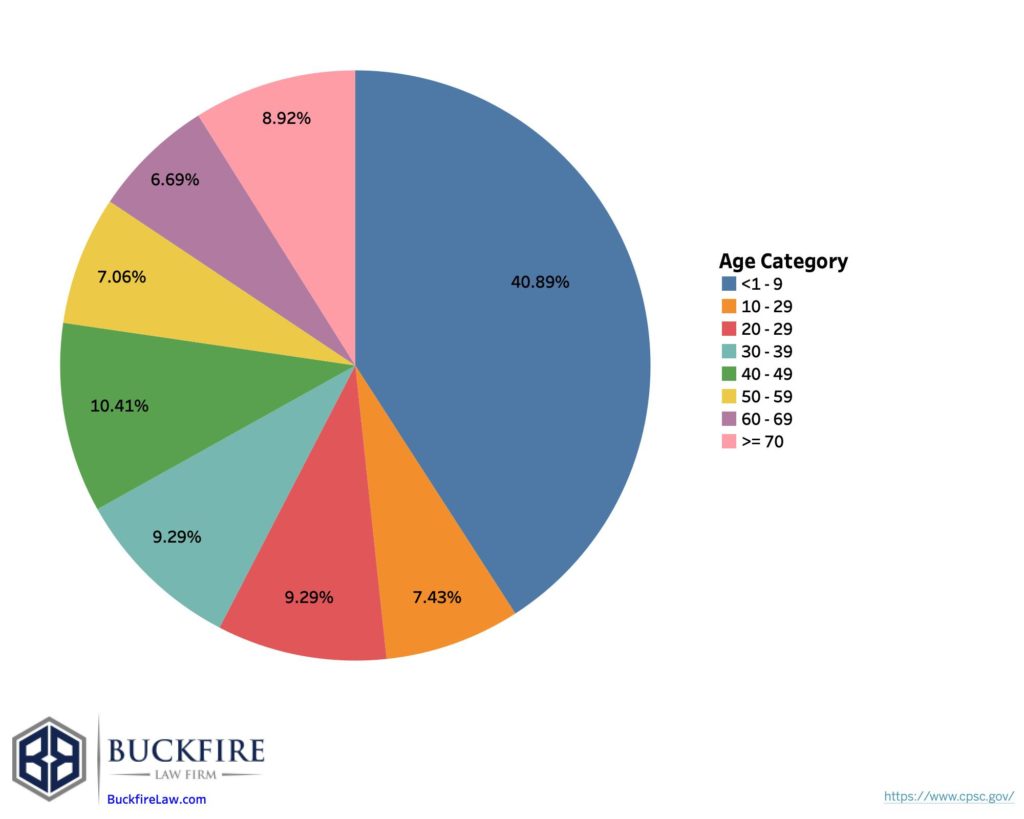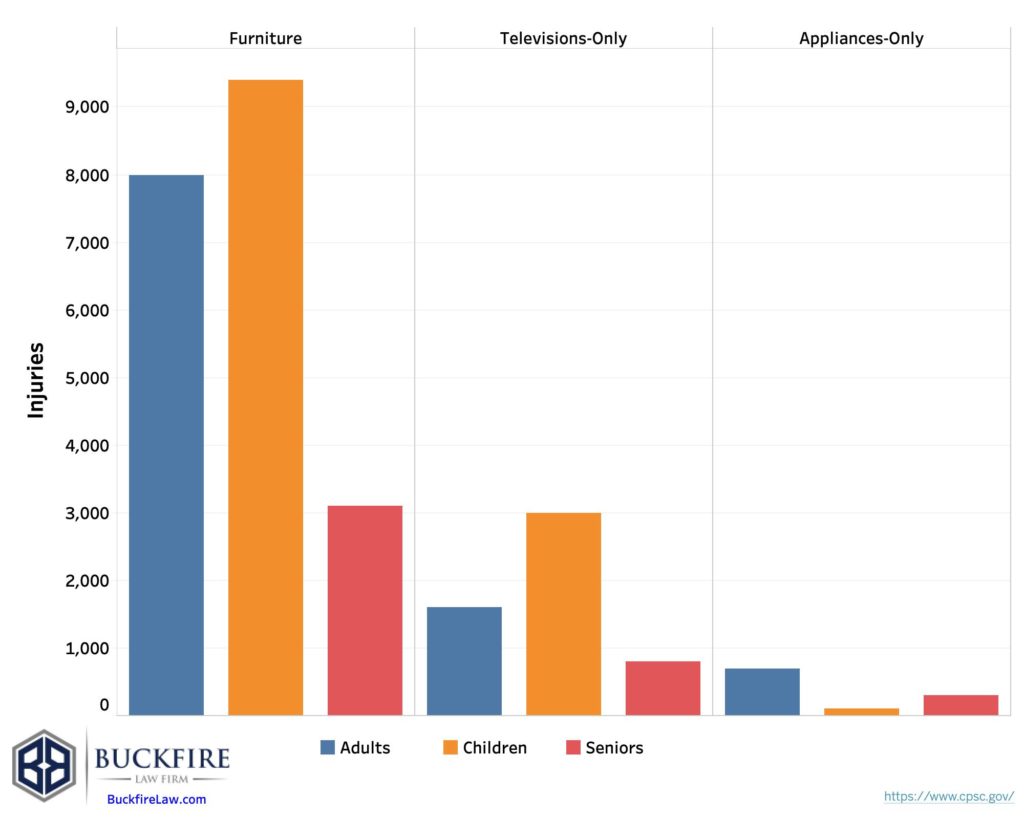The product liability lawyers at the Buckfire Law Firm represent victims of furniture tip-overs. Victims are usually innocent children who suffer serious injuries when a piece of furniture, like a dresser, or a TV falls on them. Many times, the injury occurs to the head or neck area.
Most of us know that young children are curious and that toddlers often climb onto or into furniture or open cupboard doors unless we take childproofing steps. As younger children learn to walk, they frequently use pieces of furniture for balancing themselves, sometimes pulling themselves up by holding onto furniture edges.
While many parents and caregivers know how important it is to keep dangerous products like cleaning supplies, batteries, and medicines outside the hands of young kids, the dangers posed by large and heavy pieces of furniture or TVs are not as evident. As a result, children across the country suffer serious and fatal injuries as a result of furniture and TV tip-overs.
You should be able to expect that the furniture or television you buy from a known manufacturer will be safe for use in your home. Yet when companies fail to take into account the risks of a piece of furniture tipping over, that company may be liable for damages in a product liability claim.
If your child suffered a serious injury in a furniture tip-over accident, you should get in touch with a child injury lawyer as soon as possible to find out about your options for holding the company accountable and seeking financial compensation.
- What do Individuals Need to Know About Furniture Accidents?
- What are Common Injuries from Furniture Accidents and TV Tip-Overs?
- Common Kinds of Furniture Involved in Tip-Over Accidents
What is a Furniture or Television Tip-Over Lawsuit?
Tip-over accidents happen more often than they should, and they frequently result from the furniture or electronics company’s failure to consider child safety in the creation and marketing of their products. According to the Consumer Product Safety Commission (CPSC), a “furniture tip-over can occur anytime something large and heavy becomes unbalanced.”
The CPSC further clarifies that “when kids are young and active, they tend to look for new places to explore,” which “sometimes includes climbing dressers or bookshelves, or reaching for things in high-up places that causes furniture to tip over.”
Furniture companies have a duty to warn consumers about tip-over risks associated with large and heavy pieces of furniture like dressers, bookshelves, entertainment centers, and televisions.
If companies fail to provide consumers with information about the serious risks of a tip-over or fail to provide consumers with the materials they need to properly anchor the furniture to the wall, those companies may be liable for damages. Consumers can hold businesses accountable by filing a product liability lawsuit for a tip-over accident.
Get the Facts About Furniture and TV Tip-Overs
What do parents, guardians, and caregivers need to know about furniture and TV tip-over accidents? The following are key facts and figures from the CPSC, SafeKids.org, the American Academy of Pediatrics (AAP), and KidsInDanger.org:
• Since 2000, a total of 459 kids have been killed in tip-over accidents in the U.S. alone.
• Approximately 67% of all tip-over deaths involve children between the ages of 1 and 3.5.
• Around 83% of all tip-over fatalities involve children between the ages of 1 month and 14 years.
• Between 2016 and 2018, approximately 12,500 kids have sustained injuries in tip-over accidents that were severe enough to require treatment at an emergency department.
• On average, every 43 minutes in the U.S. a child sustains an injury in a furniture or TV tip-over accident.
• Every 10 days, a child sustains an injury in a tip-over accident that results in a visit to an emergency department.
• Approximately every 12 days a person sustains a fatal injury as a result of a furniture or appliance tip-over incident.
• On average, two to three children are killed in tip-over accidents every month.
• American pediatricians identify kids under the age of 5 as those at greatest risk of injury or death in a furniture or TV tip-over incident.
• Deadliest child injuries in tip-over accidents are those that result in a brain injury or suffocation.
• Head injuries are the most common injury reported in tip-over incidents.
• More than 90% of all tip-over deaths involving kids occur in the child’s home.
• Majority of tip-over accidents in the home occur in bedrooms (51%).
• Two thirds of all furniture and TV tip-over accident deaths involve toddlers.
• Most pieces of furniture that result in tip-over incidents and deaths are never subject to safety recalls.
The pie chart below shows the distribution of tip-over injuries in emergency room visits from 2016-2018 in the United States. Children in the 0-9 age range occupy the most injuries followed by the 40-49 year age range.
These statistics should illuminate the seriousness of tip-over accidents and the need to take preventive measures if you have young children and heavy furniture in your household. At the same time, the facts and figures should emphasize how important it is for parents to hold furniture and TV companies accountable when these consumer products cause life-threatening or fatal child injuries.
Nobody should have to experience the death of a child because of a product defect. Yet, as the statistics show, defective furniture and electronics cause severe child injuries more often than most people might think.
Common Injuries in a Furniture or TV Tip-Over Accident
Furniture and TV tip-overs can cause many different kinds of injuries, but the following are among the most common according to the CPSC:
- Traumatic brain injuries (TBIs)
- Suffocation
- Contusions
- Abrasions
- Lacerations
- Fractures
- Internal organ injuries
- Spinal cord injuries
- Death
Approximately 59% of all reported injuries are brain injuries. In fatal tip-over accidents, approximately 55% of the children who were killed suffered crush injuries (were crushed by the furniture or TV), more than 20% were asphyxiated, and approximately 15% were hit or struck by the furniture. Families can file a wrongful death lawsuit for a fatal accident.
Tip-Over Injury Statistics in the United States
The bar chart below shows the average number of injuries from different appliance types being tipped over in the United States from 2016-2018. Most tip-over injuries come from moving furniture with children experiencing the largest portion of those accidents.
| Age Group | Type | Amount |
| Adults | Televisions-only | 1,600 |
| Adults | Furniture | 8,000 |
| Adults | Appliances-only | 700 |
| Children | Televisions-only | 3,000 |
| Children | Furniture | 9,400 |
| Children | Appliances-only | 100 |
| Seniors | Televisions-only | 800 |
| Seniors | Furniture | 3,100 |
| Seniors | Appliances-only | 300 |
Types of Furniture Involved in Tip-Over Accidents
Many kinds of furniture can be involved in tip-over accidents, especially any type of furniture that is heavy and is not properly anchored to a wall. The following are some frequent examples of the types of furniture and household products cited in tip-over accidents:
- Dressers
- Bookcases
- Shelving units
- Televisions
- TV stands
- Stove or oven
- Benches
- Chairs
Other types of furniture can also be implicated in tip-over incidents. It is extremely important to follow all instructions for securing furniture to the wall to prevent it from tipping over. If you have concerns about whether a large or heavy piece of furniture could tip over and injure your child, you should check safety recalls and should talk with your child’s pediatrician about the serious risks of tip-over accidents.
Product Liability Lawsuits for a Tip-Over Incident
Generally speaking, tip-over accident lawsuits that arise out of incidents in which furniture or TVs tip-over are usually brought as product liability lawsuits. Product liability law is one particular area of personal injury law that recognizes a person’s ability to file a lawsuit against the responsible party when that person sustains injuries from a product defect.
The idea behind the product liability law is that consumers should be able to purchase products without worrying that those products are not actually safe for use. Accordingly, when consumer products pose unreasonable risks of injury, a consumer who gets hurt can file a claim for compensation.
The Cornell Legal Information Institute (LII) explains that there are three basic types of product liability claims, or product defect lawsuits depending upon the specific facts of the case:
• Design defect: A consumer may file a design defect claim when there is something unreasonably dangerous or defective about the very design of a product. To be clear, the defect occurs before the product ever goes to the stage of manufacture. As such, no matter how carefully a product gets made, it will always be inherently defective. Design defect claims may be brought against the designer of the product or against the designer of one of the components of the product. For example, if a dresser is designed in such a way that it simply cannot be effectively anchored to a wall, the designer of the dresser may be liable for a design defect. At the same time, for instance, the wall anchor designed to hold the dresser in place may have been designed in such a way that it cannot actually anchor the dresser to the wall. In such a scenario, the designer of the dresser anchor may be responsible for resulting injuries.
• Manufacturing defect: A consumer may file a manufacturing defect claim when something went wrong in the manufacturing process, resulting in a defect in the product. With a manufacturing defect, there is nothing that is inherently wrong with the consumer product—the design is sound. However, when the product or one of its components got manufactured, a defect occurred. Considering furniture and TV tip-over accidents, the brackets designed to anchor a bookcase to a wall might have been manufactured incorrectly due to a problem with a machine, resulting in brackets that do not actually anchor the bookcase to the wall. As a result, tip-over incidents may occur.
• Marketing defects (failure to warn): A marketing defect is different from the other two types of product defect claims. It is especially important to understand how marketing defect claims work since many furniture and TV tip-over claims are brought as marketing defect lawsuits. A consumer may file a marketing defect claim when a consumer product was not properly marketed, or when a company failed to warn consumers about potential risks associated with the product in its marketing materials. For example, if a furniture company fails to warn consumers that a bookcase may tip over and cause serious injuries to young children, the parents of an injured child may be able to file a marketing defect lawsuit. Or, for instance, if a furniture company fails to warn consumers that a dresser may tip over and suffocate a child, the parents may be able to file a marketing defect claim. Typically, companies must warn consumers about risks associated with the intended use of the product, as well as with foreseeable uses of the product (even if those foreseeable uses are not the intended uses of the product).
Theories of Liability: Negligence Versus Strict Liability in Furniture Tip-Over Claims
Product liability lawsuits are brought under state law. Depending upon where you file a claim, there are a variety of theories of liability that you may be able to apply to your case. Those theories may include:
- Negligence (including negligent design, negligent manufacture, or negligent marketing of a product).
- Strict liability.
- Breach of warranty.
What is each of these theories of liability? While each state has its own specific laws, we can provide you with general information about these theories of liability. Most personal injury lawsuits are brought under a theory of negligence.
When it comes to negligence, the law says that a party (a furniture designer, manufacturer, or marketer, e.g.) owes a duty of care to others. If the party engages in negligent behavior or negligently fails to act and another party suffers an injury as a result, then the negligent party can be liable for damages. In general, in a negligence claim, a plaintiff must show:
- Defendant owed plaintiff a duty of care.
- Defendant breached the duty of care by acting negligently.
- Plaintiff got hurt.
- Plaintiff’s injuries were caused by the defendant’s breach of the duty of care.
How about strict liability? First, it is important to know that some states do not recognize strict liability as a theory of liability in a product defect claim. That being said, strict liability does not require an injured plaintiff to prove that the defendant was negligent.
Instead, the defendant can be “strictly liable” regardless of whether the defendant was negligent. In other words, the defendant can be financially liable for injuries even if it did not behave in a careless or negligent manner. To win a furniture tip-over case brought under a theory of strict liability, a plaintiff typically needs to be able to show:
- Product had a defect (a design, manufacturing, or marketing defect).
- Defect caused the plaintiff’s injury.
Claims brought under a theory of breach of warranty are a bit different. In a breach of warranty claim, the plaintiff is arguing that the defendant made certain promises about the product in selling it (a warranty), and the product failed to perform as the defendant promised.
Examples of Furniture and Television Tip-Over Settlements
In recent years, many types of furniture have been subject to safety recalls due to tip-over risks, and some furniture and TV companies have been held accountable for injuries and deaths in tip-over lawsuits.
The following are examples of recent lawsuits, accidents, injuries, and settlements associated with furniture and TV tip-overs in the United States:
• Midwest Folding Products $10 million settlement: A 5-year-old child was fatally crushed by a lunch table that tipped over on him at his school. The child’s mother filed a claim and settled with Midwest Folding Products for a total of $10 million.
• IKEA 2008 settlement for $2.3 million: 3-year old Katie Lambert was crushed to death by an IKEA wardrobe. Katie’s family filed a claim against IKEA, and the furniture company settled for $2.3 million.
• Million Dollar Baby $1 million settlement: The company’s four-drawer dresser tipped over and killed at least two children, one in 2007 and another in 2008. The family of the child killed in 2007 settled with Million Dollar Baby for an undisclosed amount, while the family of the child killed in 2008 settled with the company for $1 million.
• IKEA $50 million settlement in 2016: Three families whose children were killed in tip-over accidents involving the IKEA “Malm” dresser filed a $50 million claim against the company. The company settled with the three families for a total of $50 million to be divided among them, and IKEA also agreed to donate a total of $150,000 to children’s hospitals.
• Crate and Barrel 2017 bench recall: Crate and Barrel recalled nearly 7,000 wood benches after receiving reports that the bench tipped over and caused serious injuries, including disfigurement. At least four people were injured and sustained fractures, as well as an amputation.
• South Shore dresser recall in 2019: South Shore Industries issued a recall for more than 300,000 of its three-drawer “Libra” dresser after receiving two reports of the dresser being unstable and tipping over on young children. One of the children was killed in the tip-over incident.
• IKEA 2020 settlement for $46 million: IKEA recently settled a lawsuit for $46 million for the death of 2-year-old Jozef Dudek who was killed in 2017 when a three-drawer IKEA “Malm” dresser tipped over onto the toddler. The tip-over accident occurred after IKEA failed to properly recall all potentially dangerous “Malm” dressers. Notably, the child’s death also occurred after IKEA settled a lawsuit with three other families after three young children were killed in tip-over accidents. This is the largest settlement to date for a tip-over accident and suggests that tip-over lawsuits are being taken extremely seriously.
These are only some examples of recent accidents, injuries, and settlements related to furniture and TV tip-overs in the country. Many other young children have been injured and killed as a result of furniture tipping over. If your child was injured in a tip-over incident, it is essential to speak with a product liability lawyer about your options for seeking a settlement.
Statute of Limitations for Furniture and TV Tip-Over Claims
Depending upon the state where you file a claim, it is important to understand that you must file your lawsuit within the time window specified by the statute of limitations. Each state has its own statute of limitations, and those time windows differ depending upon whether you are filing a personal injury claim or a wrongful death lawsuit.
Under Michigan law, for example, the statute of limitations for most types of personal injury lawsuits is three years from the date of the injury. There is also a three-year statute of limitations for product liability cases. These apply to most cases.
However, there is an exception for children in most states. In Michigan, you can bring the lawsuit until the child’s 19th birthday. Most states have similar exceptions for minors.
It is extremely important to begin working with a furniture tip-over accident attorney as soon as possible to ensure that you remain eligible to file a claim. Once the “clock” on the statute of limitations runs out, your claim will become time-barred and you will be ineligible to seek compensation.
Possible Damages in a Settlement or Verdict
In a furniture tip-over claim, a plaintiff may be able to obtain compensatory damages, which are designed to provide a plaintiff with compensation for his or her losses. In general, compensatory damages taken two different forms:
• Economic damages (compensation for objective financial losses for which a plaintiff has a bill or a receipt, like hospital bills or lost wages).
• Non-economic damages (compensation for more subjective losses for which the plaintiff has not lost a specific dollar figure, such as for pain and suffering).
The type of damages you will be eligible to receive will depend upon state law. In general, examples of economic damages in a furniture tip-over claim involving an injured child may include but are not limited to:
- Hospital bills.
- Costs associated with surgery.
- Bills for follow-up doctor’s appointments.
- Medical equipment necessary to assist with a disability.
- Rehabilitation and therapy costs.
- Medication costs.
Examples of non-economic damages may include but are not limited to:
- Pain and suffering.
- Disfigurement.
- Loss of enjoyment of life.
If a child dies in a tip-over accident, the parents and other family can file a wrongful death lawsuit (link to WD PA page). Recoverable damages and compensation includes payouts for:
- Pain and suffering of the child prior the passing away.
- Loss of the society and companionship of the child.
- Medical expenses and bills.
- Funeral and burial costs.
Depending on where you file a claim, you may also be eligible to obtain punitive or exemplary damages. Punitive damages are awarded to the plaintiff, but they are designed to punish a defendant for particularly egregious and harmful behavior, and to deter similar behavior in the future.
Exemplary damages are paid to the plaintiff when the defendant’s behavior was especially harmful, but this type of damages award is compensatory rather than punitive in nature.
Comparative Fault or Contributory Negligence Could Impact Your Case
In furniture tip-over claims, the defendant may argue that the parent or caregiver is partially to blame for failing to properly secure or bolt the furniture to the wall. Depending upon the state in which you file a claim, comparative fault or contributory negligence could result in your damages being diminished by your percentage of fault, or it could bar your claim altogether.
Some states follow a theory known as pure comparative fault. In a pure comparative fault state, a plaintiff is permitted to recover damages as long as the defendant is found to be at least 1% at fault. In other words, even if a plaintiff is 99% at fault, she or he can still recover damages. However, the plaintiff’s damages award ultimately will be reduced by her percentage of fault.
Other states follow a theory of modified comparative fault. In these states, depending upon the specific state law, a plaintiff can recover damages if she is at fault, but only up to a certain point. Depending on the state, once a plaintiff is either 50% or more at fault, or 51% or more at fault, the plaintiff is barred from recovery entirely. Assuming the plaintiff is not barred from recovery, her damages award will be reduced by her share of the fault.
For example, if a plaintiff is awarded $1 million and is 20% at fault, the award is reduced by 20% (or by $200,000), and the plaintiff would recover $800,000. Michigan, for instance, is a modified comparative fault state in which a plaintiff is barred from recovery only once she is 51% or more at fault.
Other states use a theory known as contributory negligence. In a pure contributory negligence state, a plaintiff is barred from recovery as soon as that plaintiff is determined to be even 1% at fault. Indeed, even if a defendant is 99% responsible, the plaintiff will be barred from recovering any damages.
However, many states have laws that do not allow the negligence of a parent to reduce or affect the child’s case. These are mostly laws based upon the principle of parental immunity.
It is extremely important to have a tip-over accident lawyer on your side who can show that you do not bear any responsibility for the tip-over accident. Furniture companies need to be held accountable when they make and sell products that can cause serious child injuries and deaths.
Preventing Tip-Over Accidents Involving Furniture and Televisions
It is important to recognize that parents and caregivers may be able to prevent furniture and TV tip-over accidents. The CPSC emphasizes the following to prevent tip-over injuries: “Anchor It!”
In other words, you should always anchor your furniture and TV to the walls to prevent these products from tipping over. In addition, parents and guardians should consider the following safety tips from the American Academy of Pediatrics and SafeKids.org:
• Follow all manufacturer’s instructions for properly anchoring your furniture.
• Use a wall stud to securely anchor to the wall all dressers, bookcases, TVs, TV stands, and any other heavy furniture that typically leans up against a wall.
• When you anchor heavy furniture to the wall, you should also secure it with braces, brackets, anchors, or wall straps—whichever are appropriate for the particular piece of furniture.
• Never place televisions on furniture that is not designed to hold a TV—i.e., avoid placing TVs on dressers or tables—since TVs are more likely to tip over in these scenarios.
• Only place televisions on furniture that is low to the ground and is the appropriate size to hold a television.
• Push TVs back against the wall as far as possible.
• Keep children’s items like toys—and even items that might spark a child’s interest like food or a remote control—away from televisions to avoid tempting your child from climbing up onto the furniture and tipping the TV.
• Keep all electrical cords out of the reach of children.
• Store heavier items on lower bookshelves or in drawers that children cannot open easily.
• Put “stops” on dresser drawers to prevent children from pulling the drawers out fully (which can make a tip-over accident more likely).
Contact a Furniture Tip-Over Accident Lawyer
If your child was injured in a furniture or TV tip-over accident, you may be eligible to file a claim for compensation. Like many parents, you may be able to file a lawsuit or join a class action in order to hold the furniture or TV company accountable. Product liability lawsuits can be complicated, and it is important to have an experienced furniture tip-over accident lawyer representing you.
At Buckfire Law Firm, we are committed to helping families who have experienced child injuries or deaths from furniture and TV tip-over incidents. An advocate at our firm can begin working on your claim today.
Contact Buckfire Law Firm to learn more about how we can assist you with your furniture tip-over lawsuit. There are no legal fees unless you receive a settlement and we pay the case costs. We only get paid at the end of the case when you receive your settlement check.
(Main)
- 29000 Inkster Road
Suite 150
Southfield, MI 48034
- Phone: (248) 595-7544
- 19 Clifford St.
Suite 805 Merchants Row
Detroit, MI 48226
- Phone: (313) 992-8281
(Woodward Address)
- 1001 Woodward Ave.
Suite 505
Detroit, MI 48226
- Phone: (313) 777-8482
- 343 S. Main Street
#206
Ann Arbor, MI 48104
- Phone: (734) 888-3003
- 51424 Van Dyke Ave
#3
Shelby Township, MI 48316
- Phone: (586) 250-2626
- 432 N. Saginaw Street
Suite 413
Flint, MI 48502
- Phone: (810) 818-8182









